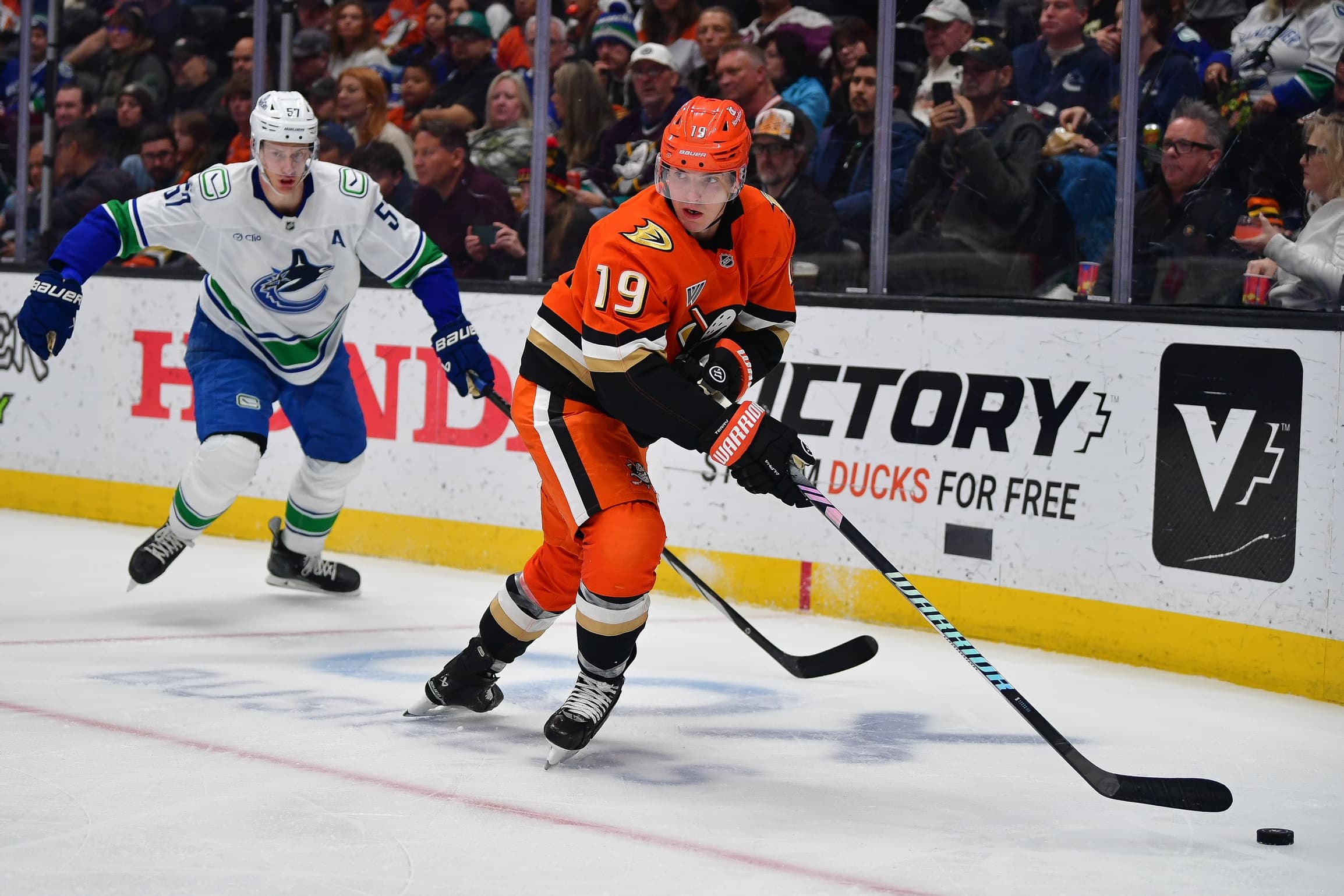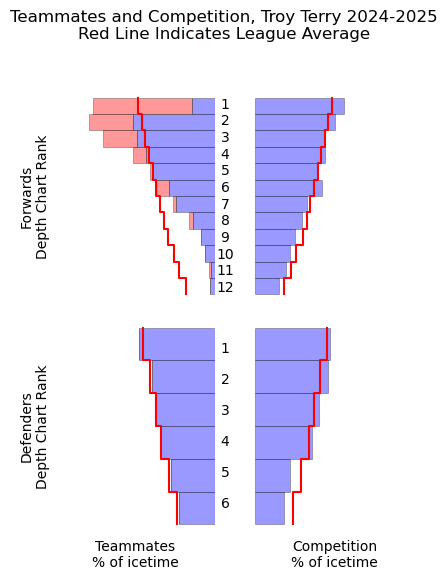Team spokesperson reached out and says Terry is not avail so we’ll see if anything comes out of it. Was told us by an individual with a different team. Also hear Jamie Benn will return to Dallas.
Nation Sites
The Nation Network
CanucksArmy has no direct affiliation to the Vancouver Canucks, Canucks Sports & Entertainment, NHL, or NHLPA
Canucks offseason trade target: Troy Terry

Photo credit: © Gary A. Vasquez-Imagn Images
Jun 18, 2025, 17:00 EDTUpdated: Jun 18, 2025, 17:01 EDT
We’ll admit that, at this point in the offseason, even we have a hard time telling between genuine rumour-mongering, pure speculation-sharing, and outright fiction-spinning.
But make no mistake: all three are occurring as the NHL gets ready to embark on the Summer of 2025.
A good example of this ambiguity comes from the rumours that cropped up this week about Anaheim’s Troy Terry.
On Tuesday night, as the Florida Panthers were about to win their second consecutive Stanley Cup, St. Louis rinkside reporter Andy Strickland tweeted simply that he had heard “Troy Terry is available from Anaheim.”
The statement got a lot of buzz, and within the hour, Strickland tweeted again to note that the Ducks had reached out to him and informed him that “Terry is not avail[able].” Strickland went on to clarify that the original info had come from another organization, and left open the possibility that the Ducks were quietly shopping Terry, without necessarily wanting that to go public quite yet.
For our part, we’ve got no way of verifying whether any of that is true, false, or entirely made up. But what we can verify is that, were Terry to actually be available, he’d instantly become a premium trade target for the Vancouver Canucks in their search for more top-six scoring.
The Player
It seems like almost yesterday that Terry was establishing his name as a clutch shootout performer at the 2017 World Juniors. But it was not, in fact, almost yesterday.
Terry has grown up a fair bit since then. He’s 27 now and will turn 28 shortly before camp opens up on the 2025/26 season. At 6’0” and 191 pounds, he’s right below average, size-wise. He’s a right-shooting right winger, which is a slightly rarer commodity than the other variety.
Terry has also developed into a consistent producer of points, though also one with lingering questions of potential still-as-of-yet-untapped.
A fifth-round pick at 148th overall in 2015, Terry had made a name for himself at the WJC, but still remained a prospect with an uphill battle to make the big leagues. He snuck in two games at the tail-end of 2017/18 after concluding his college career with the University of Denver, and then split both his rookie season of 2018/19 and his sophomore season of 2019/20 between the Ducks and the San Diego Gulls of the AHL. The pandemic-truncated season of 2020/21 saw Terry arrive full-time, but only managed seven goals and 20 points in 48 games.
Then came the 2021/22 season and Terry’s official breakout. At age 24, Terry put down 37 goals and 30 assists for 67 points in 75 games.
Oddly enough, they’re numbers that Terry has never quite replicated. The following year, for 2022/23, Terry dropped to 23 goals and 61 points in 70 games. The year after that, he was down to 20 goals and 54 points in 76 games. Then, for his most recent season of 2024/25, Terry stayed level 21 goals and 55 points in 77 games.
There are two ways to look at this scoring history. One is that Terry’s scoring has trended downward, and that’s true enough.
Another is that, downward trend or not, Terry has turned himself into a consistent 50-plus point scorer, with the proven ability to score a little more than that under the right circumstances.
But the most important perspective to take here is the one with context, and that context says that Terry has had to really round out his overall game for the Ducks. As someone who was at the earliest frontier of the Anaheim rebuild, Terry has quickly become an elder statesman for the ever-younger Ducks. He’s taken that responsibility in stride by diversifying his offensive contributions, tightening up in his own end, and earning an ‘A’ on his sweater for the past two seasons.
You won’t find much evidence of this two-way transformation in Terry’s statline. His analytics have often hovered just below the 50% threshold, as they did in 2024/25 with a 49.35% Corsi, a 49.04% shot-share, a 48.29% xG rate, and 47.11% control of the scoring chances.
But sparkling analytics are hard to come by on non-playoff teams, and the Ducks haven’t been a playoff team in a while. And for the majority of their young talent, the on-ice job is often just to score – but for Terry, it’s to score and defend.
He takes on both a top-six offensive deployment and the toughest defensive matchups of any Anaheim forward.

From HockeyViz.com
Terry was the Ducks’ top power play minute receiver in 2024/25, and while he took a step back on the penalty killing front, he’s been a major contributor there in the past.
In short, this is a player who has been asked to do a lot by the Ducks over his first four full seasons in the NHL – and who has, for the most part, done it.
The Cost
Put together everything we said in the last section, and you’ll understand why some – and not just those in the Anaheim organization – are skeptical about Terry’s availability.
At the very least, it’s enough to know that even if he hits the trade block, Terry won’t be available for cheap.
First, we probably have to figure out why Anaheim might be willing to trade him in the first place.
It’s not cap space. The Ducks have some $32 million on hand for the 2025 offseason already, and Terry is on the books for another five seasons at a $7 million cap hit. He signed that deal two years ago, and some would argue that he hasn’t quite lived up to that salary since. But, at the same time, with NHL salaries set to skyrocket, Terry’s deal is going to only look more reasonable as time marches on.
No, if Terry is moving, it’s probably more of a roster management maneuver.
The Ducks just acquired the 34-year-old Chris Kreider, presumably with the intention of adding him to their top-six forwards. That group already includes young names like Leo Carlsson, Mason McTavish, Cutter Gauthier, and Trevor Zegras. Also on hand are vets like Ryan Strome, Frank Vatrano, and Alex Killorn. Some prospects like Bennett Sennecke are on the way sooner rather than later, too.
And then, yes, there’s Terry. He’s both the most expensive of the bunch and a little redundant, especially when it comes to scoring. That first group are all thought to be players somewhat on the upswing. Terry could be perceived as one reaching the zenith of his own prime.
If the Ducks are looking to trade Terry, we imagine it’s to clear space in their forward corps for the younger players to grow, save future cap for those younger players’ eventual contract extensions, and to cash in on a value asset before it starts to depreciate.
So what would that leave them looking for?
Anaheim is still relatively flush with draft picks, so that’s not a major priority for them. They’d certainly take a look at the Canucks’ 15th overall pick, but it’s probably not their first ask.
Forget about any interest in the Canucks’ plethora of great-to-solid D prospects, too. The Ducks have one of the brightest future bluelines in the NHL, and they’re already loaded all the way up there.
We imagine the general thrust of Anaheim’s activities this offseason will be to become a better on-ice team with the hope of moving back closer to a playoff position.
On that front, we must consider a swap involving Terry and Conor Garland. The Canucks’ winger is a year older and has produced at a lesser rate than Terry over the past few seasons, but is also cheaper and could be seen as having a greater on-ice impact. For as good as Terry has become defensively, Garland is definitely better, and Terry cannot hold a candle to Garland’s peskiness.
The Ducks would be trading the overall better player, signed for longer. But they’d be getting back someone who could maybe make more of a difference in 2025/26, and who certainly seems more likely to sign an extension in Anaheim than he is in Vancouver.
The Canucks probably need to include a sweetener in the exchange, but perhaps not a major one.
Another name the Ducks could covet is Jonathan Lekkerimäki, as a young, mostly-NHL-ready sniper able to be paired with any of their young centres. From where we’re sitting, however, the Garland approach should probably be their preference – if their preference is to move Terry at all, that is.
The Fit
The Canucks need scoring, and Terry provides it. At the very least, he’s putting up 50 points, and were he to have some of his defensive responsibilities lessened in Vancouver, one could imagine him getting back toward those heady 37-goal days.
Terry also offers the Canucks the chance to add offence to their roster without sacrificing any defence. Terry would come in as an ostensible Brock Boeser replacement, and while he’s not quite the goal-scoring equal there, he’s at least as good as Boeser is in his own end, if not better. At five more years of $7 million, we’d also hazard a guess that Terry’s remaining contract is less than whatever Boeser is about to sign as a UFA.
Without knowing who the Canucks are going to target as their 2C, it’s hard to say exactly where Terry would fit into the lineup. But we really like the option of placing a defensively sound right shot on Elias Pettersson’s wings. As much as Pettersson’s offence has wavered, he hasn’t really lost a step defensively. If his own production can bounce back, Pettersson and Terry would make for two-thirds of a top-six line that can also handle matching up with opposing top lines, and that’s something of immense value.
Age-wise, Terry aligns a little better with the Canucks’ core than he does with Anaheim’s.
As has been the case with each trade target we’ve discussed, the price-tag is key here, and while this is a player worth pursuing, the Canucks do not have the assets on hand to really overpay for any of their targets.
If Terry is indeed available and a reasonable cost can be agreed on, the Canucks should be very, very interested. If not, they should move on to a target for which a reasonable cost can be agreed.
READ NEXT: Canucks 2025 NHL free agency target: Jack Roslovic
Sponsored by bet365
Recent articles from Stephan Roget
Breaking News
- The Stanchies: Canucks nearly ruin the perfect tank game, still find a way to lose 5-3 to Sabres
- Instant Reaction: Canucks battle back to make it close, but fall 5-3 to Sabres
- ‘Do it for once, please’: Jannik Hansen wants the Canucks to sell high and trade Kiefer Sherwood
- Blackfish: Abbotsford Canucks’ post-holiday road work, World Junior medals, and a CHL trade watch
- Canucks prospect Parker Alcos traded to the Kelowna Rockets: report
